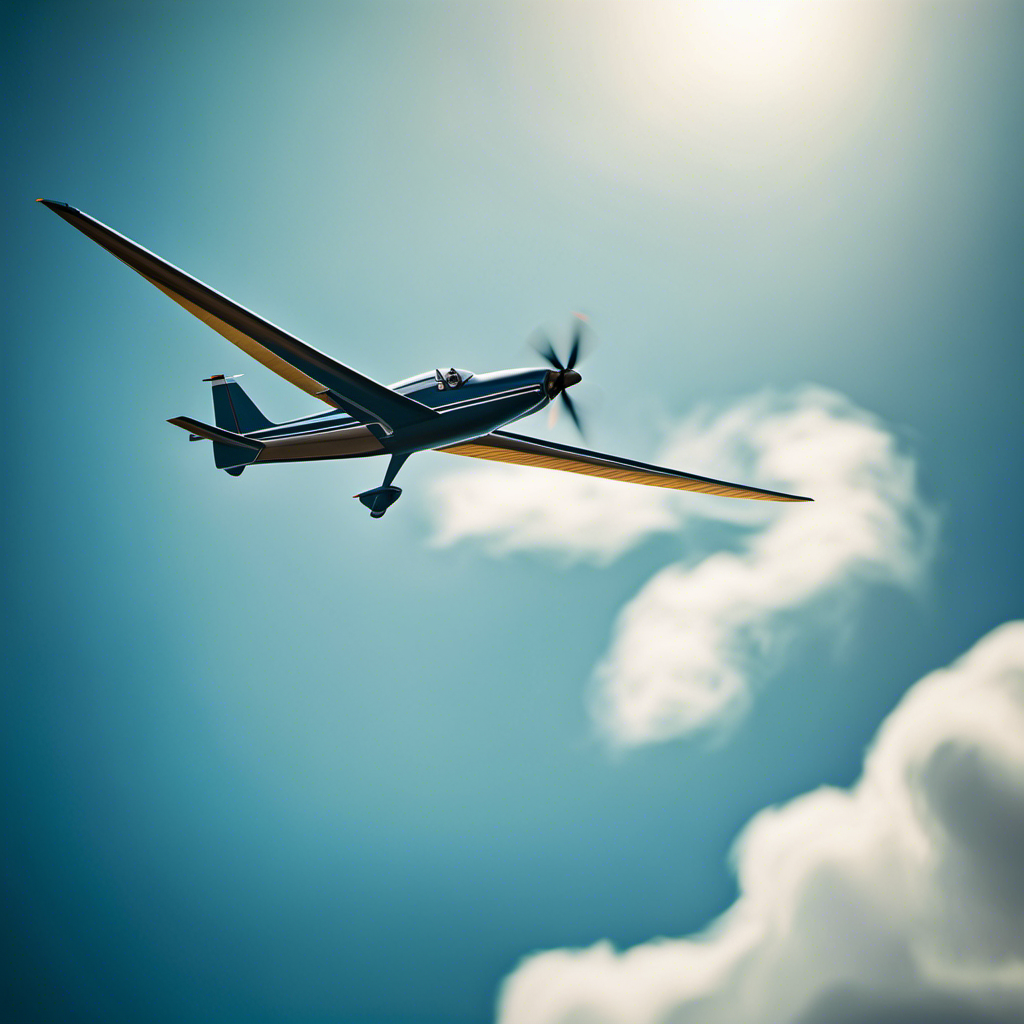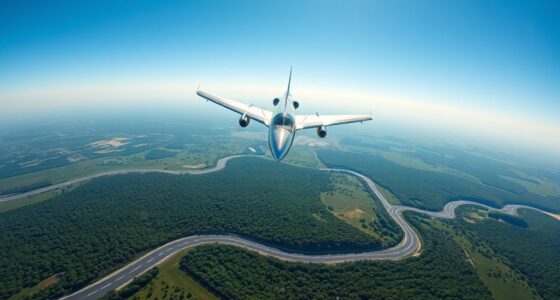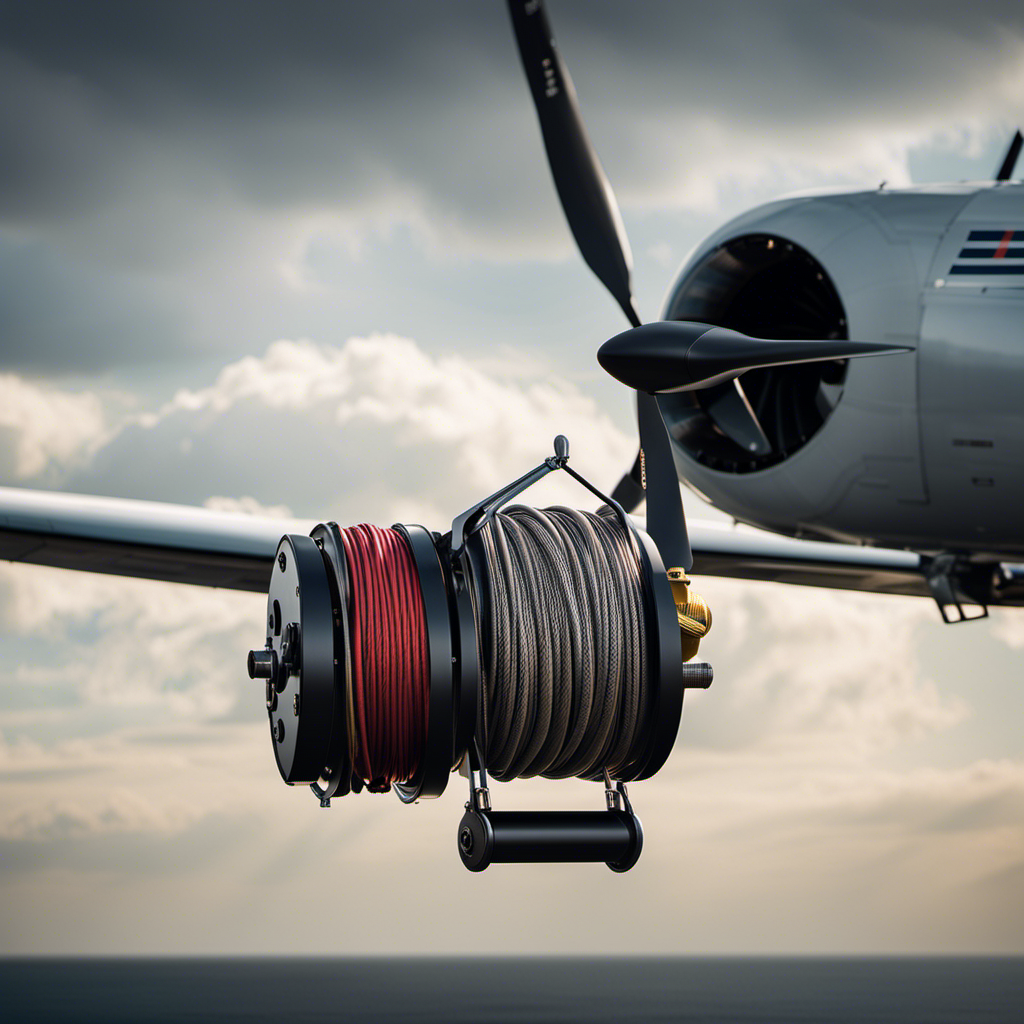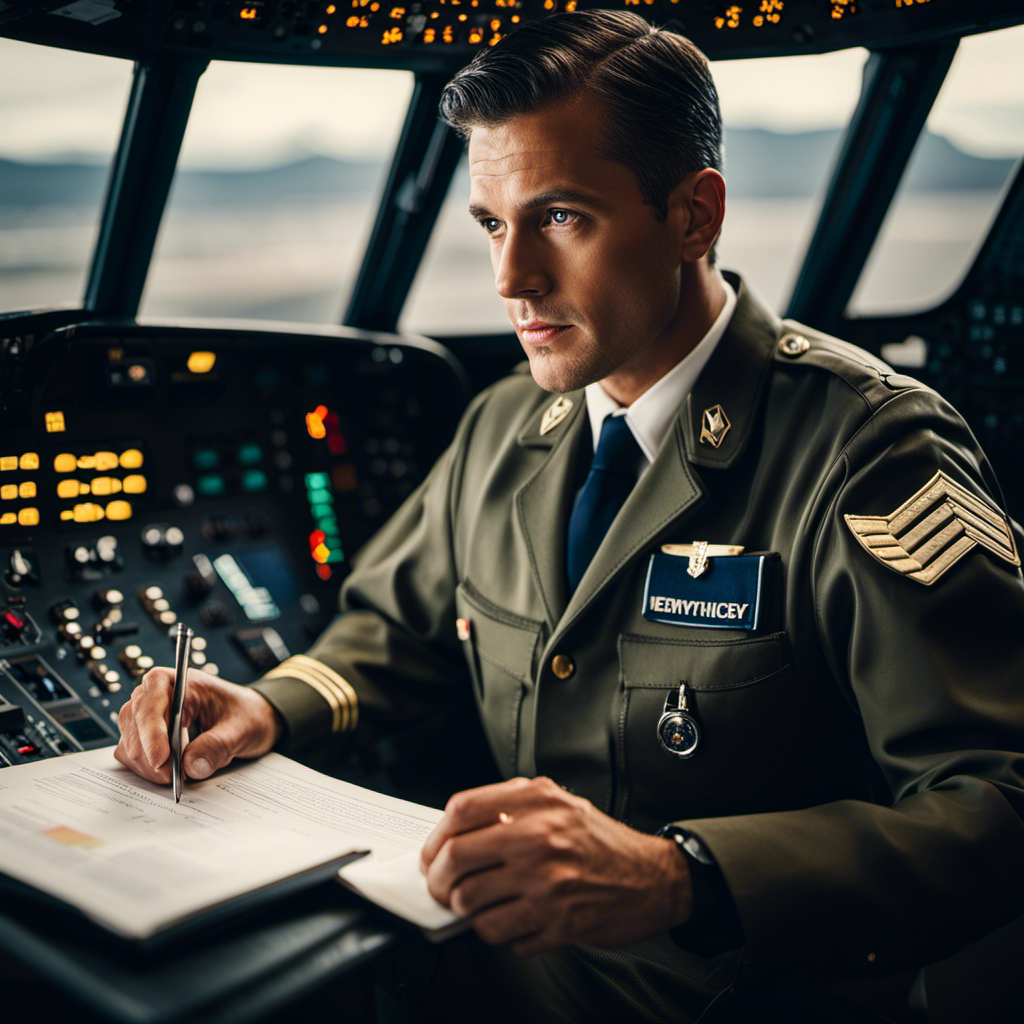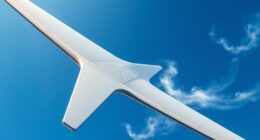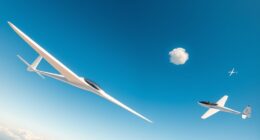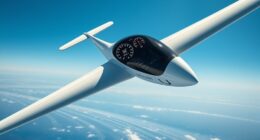Have you ever imagined soaring through the air in complete silence, without the roar of an engine? Envision yourself gliding effortlessly through the sky, feeling the gentle breeze against your skin as you glide through the clouds.
In this article, we will explore the world of glider planes – a marvel of aviation that relies solely on the forces of nature to stay aloft. Discover the history, principles, and techniques behind these magnificent flying machines, and learn why so many pilots find pure joy in the art of gliding.
Key Takeaways
- Glider planes have a long history dating back to the late 19th century, with significant advancements made by Otto Lilienthal and the Wright brothers.
- Glider planes rely on lift, weight, thrust, and drag for flight, with lift generated by the wings and weight balanced by the lift force.
- The components of glider planes include wings, fuselage, horizontal stabilizer, vertical stabilizer, and control surfaces.
- Launching methods for glider planes include winch launching, which provides quick takeoff speed, and flying techniques require precise control and understanding of aerodynamics.
History and Evolution of Glider Planes
You’ll be fascinated to learn about the history and evolution of glider planes.
Glider planes, also known as sailplanes, have a long and interesting history that dates back to the late 19th century. The first successful glider flight was accomplished by Otto Lilienthal in 1891. Lilienthal’s experiments paved the way for the development of glider planes as we know them today.
In the early 20th century, pioneers like the Wright brothers made significant advancements in glider design and control. Over the years, glider planes have undergone numerous improvements in terms of materials, aerodynamics, and technology. Today, modern glider planes are sleek, efficient, and capable of soaring for long distances using only natural sources of lift.
Now, let’s delve into the principles of flight for glider planes.
Principles of Flight for Glider Planes
To understand how glider planes stay in the air, it’s important to grasp the principles of flight. Glider planes rely on the same principles as any other aircraft: lift, weight, thrust, and drag.
Lift is generated by the wings as air passes over them, creating a pressure difference that keeps the glider airborne. The weight of the glider is balanced by the lift force, allowing it to stay in the air.
Thrust is not provided by an engine in a glider, but instead by gravity pulling the aircraft downwards, which creates a forward motion. Drag, the resistance of the air, opposes the glider’s forward motion.
Components and Design of Glider Planes
The wings of a glider create lift by generating a pressure difference as air passes over them. Glider planes are designed with specific components to optimize their performance. Here is a table that outlines the main components and their functions in a glider plane:
| Component | Function |
|---|---|
| Wings | Generate lift by creating a pressure difference as air flows over them. |
| Fuselage | Provides structural support and houses the cockpit and payload. |
| Horizontal Stabilizer | Controls pitch stability and helps maintain level flight. |
| Vertical Stabilizer | Controls yaw stability and prevents the plane from spinning. |
| Control Surfaces (elevator, ailerons, rudder) | Allow the pilot to control the glider’s movements in pitch, roll, and yaw. |
Understanding the components and design of a glider plane is crucial for safe and efficient flight. Now, let’s explore the various launching methods for glider planes.
Launching Methods for Glider Planes
One common method of launching glider planes is by using a winch to rapidly reel in the cable attached to the aircraft. This method allows the glider to gain altitude quickly and efficiently. Here are four key points to understand about launching glider planes using a winch:
-
Speed: The winch rapidly reels in the cable, allowing the glider to reach takeoff speed in a short amount of time.
-
Tension: The cable is under tension during the launch, ensuring a smooth and controlled ascent.
-
Safety: The winch operator carefully monitors the launch, ensuring that the cable remains taut and the glider stays on the correct trajectory.
-
Versatility: Winch launching can be done on a variety of surfaces, making it a popular choice for glider pilots.
With the glider successfully launched, let’s now explore the flying techniques and skills that glider pilots employ to navigate the skies.
Flying Techniques and Skills for Glider Pilots
Mastering flying techniques and skills as a glider pilot requires precise control and a deep understanding of aerodynamics. As you take to the skies in a glider, you must learn to manipulate the controls with finesse, using subtle movements to maintain altitude and make turns. You’ll need to develop a keen sense of airspeed, as gliders rely solely on atmospheric currents for propulsion.
By studying the principles of aerodynamics, you’ll gain insight into how lift, drag, and gravity affect your flight. As you become more proficient, you’ll learn advanced techniques such as thermaling, where you use rising columns of warm air to gain altitude. These skills will form the foundation for your safe and exhilarating glider flights.
Speaking of safety, let’s now explore the important measures and regulations for glider flying.
Safety Measures and Regulations for Glider Flying
When flying a glider, you must adhere to safety measures and regulations to ensure a secure and enjoyable experience. Here are four important safety measures to keep in mind:
-
Pre-flight Inspections: Before taking off, thoroughly inspect the glider for any signs of damage or malfunction. Check the control surfaces, cables, and instruments to ensure everything is in proper working condition.
-
Weather Monitoring: Stay updated on the weather conditions before and during your flight. Avoid flying in strong winds, thunderstorms, or low visibility. Always prioritize safety over your desire to fly.
-
Communication: Maintain good communication with air traffic control and other pilots in the area. Use the correct radio frequencies and follow instructions to avoid any potential conflicts or accidents.
-
Emergency Procedures: Familiarize yourself with emergency procedures and practice them regularly. Be prepared for situations like a sudden loss of altitude or an in-flight emergency.
Advantages and Benefits of Glider Planes
Glider planes offer several advantages and benefits worth considering. Firstly, their environmental impact is minimal as they rely solely on wind currents for propulsion, resulting in zero emissions.
Additionally, glider planes are cost-effective and affordable compared to traditional powered aircraft, making them accessible for enthusiasts and hobbyists.
Lastly, flying a glider plane is not just a thrilling experience, but also an opportunity for personal growth and skill development as it requires mastering the art of using thermals and reading the wind for navigation.
Environmental Impact and Sustainability
The environmental impact of glider planes is a topic of concern for many. Gliders are inherently eco-friendly as they do not emit any greenhouse gases or pollutants during flight. They rely solely on the power of natural elements like wind and thermals to stay airborne. This makes them a sustainable alternative to conventional powered aircraft.
Gliders also have a minimal noise footprint, reducing noise pollution in the surrounding environment. Additionally, gliders require less infrastructure and maintenance compared to traditional airplanes, resulting in lower energy consumption and environmental impact. The sustainability of glider planes makes them a viable option for reducing carbon emissions in the aviation industry.
Transitioning from discussing the environmental impact, let’s now explore the cost-effectiveness and affordability of glider planes.
Cost-effectiveness and Affordability
If you’re looking for a cost-effective and affordable option, you’ll be pleased to know that gliders can be a budget-friendly choice for aviation enthusiasts. These soaring aircraft offer a thrilling and economical way to take to the skies.
Here are a few reasons why gliders are a great option for those on a budget:
-
Gliders require no fuel: Unlike powered aircraft, gliders rely solely on the power of the wind to stay aloft. This means you won’t have to worry about expensive fuel costs.
-
Lower maintenance expenses: Gliders have simpler and less complex systems compared to powered planes, resulting in lower maintenance and repair costs.
-
Accessible training programs: Glider flight schools often offer affordable training programs, making it easier for aspiring pilots to get their wings.
With the cost-effectiveness of glider aviation, you can embark on a journey of personal growth and skill development.
Personal Growth and Skill Development
After considering the cost-effectiveness and affordability of glider planes, let’s explore the personal growth and skill development that can be gained from this exhilarating hobby.
Engaging in glider flying allows you to develop a range of valuable skills. Firstly, it enhances your ability to make quick decisions and think critically, as you navigate through the ever-changing wind patterns.
Secondly, it hones your concentration and focus, as you must maintain constant awareness of your surroundings.
Additionally, glider flying promotes self-discipline and patience, as you learn to wait for the right conditions and perfect your techniques.
Lastly, it fosters a sense of self-confidence and accomplishment, as you master the art of soaring through the skies with grace and precision.
Now, let’s delve into the exciting world of glider plane competitions and events.
Glider Plane Competitions and Events
Glider plane competitions and events often attract enthusiasts from around the world. These gatherings provide a platform for pilots to showcase their skills and compete against one another in different categories. From distance flying to aerobatics, glider plane competitions offer a range of challenges that push pilots to their limits. Participants are evaluated based on factors like accuracy, technique, and overall performance. To give you an idea of the diversity in glider plane competitions, here is a table showcasing some popular categories:
| Category | Description |
|---|---|
| Distance Flying | Pilots compete to cover the longest distance possible. |
| Aerobatics | This category focuses on precision and skill in maneuvers. |
| Speed | Pilots aim to complete a specific course in the least time. |
| Cross-Country | Competitors navigate through a set course, testing their navigation skills. |
| Team Flying | This category emphasizes teamwork and synchronization. |
These events not only offer a thrilling experience for spectators but also serve as opportunities for pilots to learn from one another and improve their techniques. Transitioning into the subsequent section, let’s explore the achievements of famous glider pilots and notable flights.
Famous Glider Pilots and Notable Flights
In this discussion, you’ll explore the fascinating world of glider aviation. You’ll delve into the achievements of notable glider pilots and their groundbreaking flights.
First, you’ll learn about Steve Fossett and the Perlan Project. This project aimed to soar to unprecedented altitudes using atmospheric waves.
Next, you’ll discover the incredible contributions of Hanna Reitsch during World War II. She played a crucial role in glider operations and made significant advancements in this field.
Steve Fossett and the Perlan Project
Steve Fossett’s involvement in the Perlan Project significantly contributed to advancements in glider plane technology. His groundbreaking achievements in glider flight opened up new possibilities for exploration and research.
Here are some key highlights of Fossett’s contributions:
- Fossett piloted the Perlan II glider to a record-breaking altitude of 76,124 feet, setting a new world record for sustained flight.
- The Perlan Project aims to study the Earth’s atmosphere and climate by utilizing the unique capabilities of glider planes.
- Fossett’s flights helped demonstrate the potential of using glider planes for high-altitude research and data collection.
- The Perlan Project’s advancements in glider technology have paved the way for future developments in unmanned glider systems.
Fossett’s pioneering work in the Perlan Project has inspired further exploration and innovation in glider plane technology.
Now, let’s delve into the fascinating world of Hanna Reitsch and World War II glider operations.
Hanna Reitsch and World War II Glider Operations
As you explore the world of Hanna Reitsch and World War II, you’ll discover the incredible role she played in the operations of soaring aircraft during this historic period.
Reitsch, a German aviator, was known for her exceptional skills and courage in flying glider planes. She was one of the few female test pilots and became an integral part of the war effort.
Reitsch flew various types of gliders, including the DFS 230, which was used to transport troops during the Battle of Fort Eben-Emael in 1940. She also piloted the Messerschmitt Me 163 Komet, a rocket-powered glider that held the record for the fastest speed in a glider.
Her contributions to glider aviation during World War II paved the way for future advancements in the field. Transitioning to the subsequent section about records and milestones in glider aviation, Reitsch’s achievements set the stage for even more remarkable accomplishments in the years to come.
Records and Milestones in Glider Aviation
Reitsch’s exceptional skills and courage in flying soaring aircraft during World War II set the stage for remarkable accomplishments and milestones in the field of glider aviation. Her impressive achievements not only demonstrated the potential of glider planes in military operations but also paved the way for advancements in this specialized form of aviation.
From breaking world records for altitude and duration to successfully navigating challenging weather conditions, Reitsch’s contributions pushed the boundaries of what was previously thought possible in glider flying. Her legacy continues to inspire and motivate glider pilots around the world to strive for excellence and explore new frontiers in this exhilarating sport.
With such a rich history and a growing community of enthusiasts, resources and opportunities for glider flying are more accessible than ever before.
Resources and Opportunities for Glider Flying
If you’re interested in glider flying, there are several resources and opportunities available to you.
Glider clubs and training centers offer a supportive community and professional instruction to help you learn and improve your skills.
Additionally, there are options for glider rental and ownership, allowing you to enjoy the freedom of flying whenever you want.
Glider Clubs and Training Centers
Glider clubs and training centers offer instruction on how to fly a glider plane. These organizations provide a structured and safe environment for individuals who are interested in learning how to pilot these unique aircraft. Here are some key features and benefits of glider clubs and training centers:
-
Experienced Instructors: Glider clubs and training centers have qualified and experienced instructors who will guide you through the learning process. They will teach you the necessary skills and techniques to become a proficient glider pilot.
-
Comprehensive Training Programs: These organizations offer comprehensive training programs that cover all aspects of glider flying, including ground instruction, flight simulation, and actual flight training. You will learn about aerodynamics, navigation, weather patterns, and emergency procedures.
-
Access to Gliders: Glider clubs and training centers provide access to a variety of glider planes, allowing you to gain experience on different models and sizes.
With the necessary training and practice, you can eventually move on to glider rental and ownership options, which provide further opportunities for exploration and adventure in the world of glider flying.
Glider Rental and Ownership Options
When it comes to exploring glider rental and ownership options, you’ll have the chance to take your flying skills to the next level and embark on thrilling adventures in the sky.
Glider rental allows you to experience the freedom of flying without the commitment of owning your own aircraft. Many glider clubs and training centers offer rental services, providing you with access to a variety of glider models. Renting a glider gives you the opportunity to fly different types of aircraft and gain valuable experience.
On the other hand, if you’re looking for a more long-term commitment, owning a glider can provide you with the freedom to fly whenever you want. It also allows you to customize your glider to suit your preferences.
Whether you choose to rent or own, the world of glider flying awaits you.
And now, let’s move on to glider flying schools and certification programs, where you can further enhance your skills and knowledge in glider aviation.
Glider Flying Schools and Certification Programs
Attending glider flying schools and certification programs can help enhance your skills and knowledge in the world of glider aviation. These programs offer comprehensive instruction, providing in-depth training from experienced instructors who teach you the fundamentals of glider flying.
In addition to the theoretical knowledge, these programs also provide ample opportunities for you to gain practical experience in flying gliders. This hands-on experience allows you to hone your skills and build confidence in your abilities.
Furthermore, attending these schools and programs opens up networking opportunities. You have the chance to connect with fellow enthusiasts and professionals in the glider aviation community. This expands your network and allows you to learn from their experiences and insights.
Frequently Asked Questions
How much does a glider plane cost?
Glider planes can vary in price depending on factors such as brand, size, and features. However, on average, a glider plane can cost anywhere from $10,000 to $200,000.
What is the maximum altitude a glider plane can reach?
A glider plane can soar to great heights, reaching astonishing altitudes without the aid of an engine. With skillful piloting and favorable air currents, gliders can reach maximum altitudes of up to 50,000 feet.
Are glider planes allowed to fly at night?
Yes, glider planes are allowed to fly at night. However, pilots must follow specific guidelines, such as using lights and instruments for navigation, and ensuring the conditions are suitable for safe nighttime flying.
Can a glider plane be converted into a motorized aircraft?
Yes, a glider plane can be converted into a motorized aircraft. This process involves adding an engine to provide propulsion. However, it’s worth noting that only about 10% of gliders are converted into motorized aircraft.
Do glider pilots need a different type of license compared to pilots of other aircraft?
Yes, glider pilots do need a different type of license compared to pilots of other aircraft. They must obtain a glider pilot license, which requires specific training and qualifications to safely operate a glider plane.
Conclusion
In conclusion, glider planes are the epitome of thrilling aviation adventures! With their rich history and evolution, these magnificent machines have become the perfect blend of elegance and excitement.
From the principles of flight to the intricate components and design, glider planes are a marvel of engineering. Launching methods and flying techniques require skill and finesse, making glider pilots true masters of the sky.
The advantages and benefits of glider planes are simply unmatched, offering a unique and serene flying experience.
So, strap in and prepare for a soaring adventure of a lifetime!
